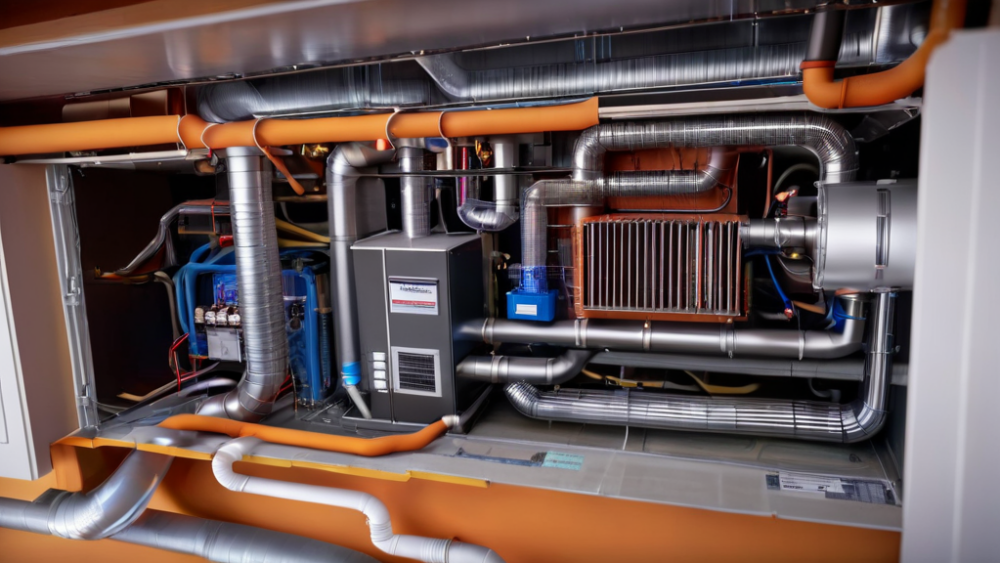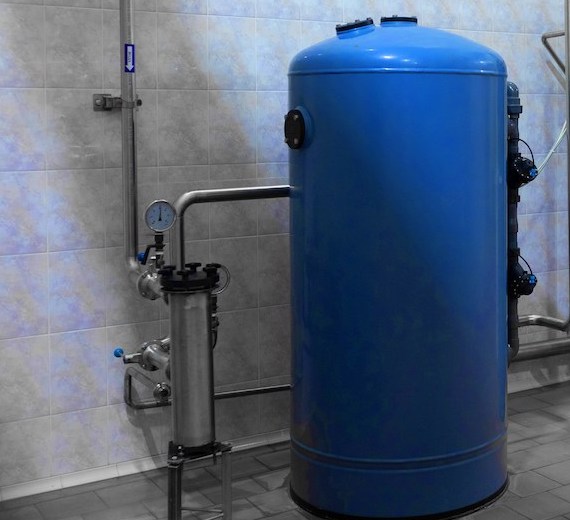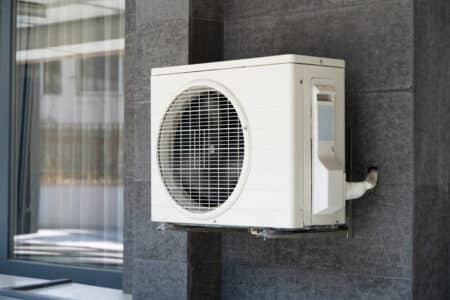Your HVAC system works by using a thermostat to manage temperature settings. For heating, you’ll have mechanisms like furnaces, boilers, or heat pumps. Cooling uses a refrigeration cycle along with good airflow. Ventilation can be natural or mechanical, ensuring fresh air circulates. Efficient air distribution keeps your home comfortable year-round. Regular maintenance like cleaning filters and inspecting ducts is essential for peak performance. There’s a lot more to how each component plays its part seamlessly.
Table of Contents
ToggleThermostat Function
The thermostat is the control center of your HVAC system, regulating the temperature by signaling when to heat or cool your home. It measures the current temperature and compares it to your desired setting. If there’s a difference, it sends a signal to your HVAC unit to adjust accordingly. Accurate temperature calibration is essential for maintaining comfort and efficiency. If your thermostat isn’t calibrated correctly, it might cause your system to cycle too frequently or not enough, leading to discomfort and higher energy bills.
Modern technology has introduced smart thermostats, which offer enhanced functionality and convenience. These devices not only allow you to set temperature schedules but also learn your preferences over time. They can adjust the temperature based on your habits and even detect when you’re away from home, making real-time adjustments to save energy. Additionally, smart thermostats can be controlled remotely via smartphone apps, giving you the flexibility to manage your home’s temperature from anywhere.
Heating Mechanisms
An HVAC system‘s heating mechanisms guarantee your home stays warm during colder months by utilizing various methods such as furnaces, heat pumps, and boilers. Each of these methods operates differently to make sure you remain comfortable.
Furnaces are one of the most common heating systems. They work by burning fuel, usually natural gas, to produce heat. This heat is then distributed throughout your home via a network of ducts.
On the other hand, boilers heat water to provide warmth. The hot water circulates through pipes to radiators or radiant heating systems, where it releases heat to warm up the surrounding area.
Heat pumps are another efficient option. They don’t generate heat like furnaces or boilers. Instead, they transfer heat from the outside air or ground into your home. In colder climates, heat pumps can be paired with a secondary heating source for added efficiency.
Radiant heating systems deserve a special mention. They offer a unique way to warm your home by heating floors, walls, or ceilings. This type of system provides consistent and even heat distribution, minimizing cold spots and enhancing overall comfort.
Understanding these mechanisms can help you maintain and choose the best heating solution for your home.
Cooling Processes
To understand how your HVAC system cools your home, you first need to grasp the refrigeration cycle. This cycle involves the movement of refrigerant through various components to absorb and expel heat.
Additionally, proper airflow and heat exchange are important for peak cooling efficiency.
Refrigeration Cycle Explained
Understanding the refrigeration cycle is essential for grasping how your HVAC system cools your home. At the heart of this cycle lies the compressor operation, where everything begins. The compressor’s role is to pressurize the refrigerant, transforming it into a high-pressure, high-temperature gas. This pressurized gas then travels through the system, releasing heat as it condenses into a liquid.
Next, the refrigerant flows through the expansion valve, which lowers its pressure and temperature, turning it into a cold, low-pressure liquid. This cold refrigerant then moves through the evaporator coil, where it absorbs heat from your home’s air, effectively cooling it. As the refrigerant absorbs heat, it evaporates back into a gas, ready to return to the compressor and start the cycle over.
Different refrigerant types, like R-22 or R-410A, can significantly impact the efficiency and environmental friendliness of your HVAC system. R-410A, for instance, operates at higher pressures and is more environmentally safe compared to older refrigerants like R-22.
Airflow and Heat Exchange
In an HVAC system, efficient airflow and heat exchange are essential for maintaining ideal indoor temperatures. You’ll find that the cooling process relies heavily on these two components working seamlessly together.
First, let’s talk about blower fans. These fans are responsible for moving air across the evaporator coils, where the air gets cooled. The cooler air is then pushed through the ductwork and distributed throughout your home.
The design of your ductwork plays a vital role in this process. If the ductwork design is flawed, it can lead to inefficiencies, such as uneven cooling or increased energy consumption. Well-designed ducts ensure that air flows smoothly and reaches every room effectively.
Heat exchange occurs in the evaporator coils, where the refrigerant absorbs heat from the air. The blower fans then circulate this cooled air through the ducts. Simultaneously, the absorbed heat is transferred outside via the condenser coils.
Ventilation Systems
A well-designed ventilation system guarantees a constant flow of fresh air throughout your home.
You might be surprised to learn there are two main types: natural ventilation and mechanical ventilation.
Natural ventilation relies on openings like windows, doors, and vents to allow fresh air to enter and stale air to exit. It’s a simple and energy-efficient method, but it’s not always sufficient, especially in tightly-sealed, modern homes.
Mechanical ventilation steps in when natural ventilation falls short. It uses fans and duct systems to control airflow in and out of your home.
There are several types of mechanical ventilation systems, including exhaust-only, supply-only, and balanced systems.
Exhaust-only systems remove stale air, while supply-only systems bring in fresh air.
Balanced systems do both, providing the most effective solution for maintaining indoor air quality.
Air Circulation
Understanding air circulation in your HVAC system helps you guarantee top performance.
You’ll learn about airflow pathways, the importance of ventilation and filtration, and tips for improving circulation efficiency.
Let’s get started with the key points or call an HVAC technician for Maintenance.
Airflow Pathways Explained
Airflow pathways in an HVAC system guarantee that conditioned air reaches every corner of your home efficiently. To achieve this, the duct layout and blower operation play pivotal roles. The duct layout consists of a network of pathways that distribute air from the HVAC unit to various rooms. Think of it as your home’s circulatory system, where ducts act like arteries delivering warm or cool air to every space.
Blower operation is equally important. The blower is a fan that pushes air through the ducts. When your HVAC system turns on, the blower activates, driving air through the ductwork. The efficiency of this process depends on the blower’s power and the design of the ducts. If the ducts are poorly designed or obstructed, air won’t flow properly, leading to uneven heating or cooling.
You mightn’t realize it, but even small issues in the duct layout or blower operation can have a significant impact on comfort and energy efficiency. Regular maintenance is crucial to make sure that both components function well. A well-maintained system means consistent airflow, which translates into a more comfortable living environment and lower energy bills.
Ventilation and Filtration
Alongside efficient airflow pathways, ensuring proper ventilation and filtration is essential for maintaining indoor air quality in your HVAC system. Ventilation involves bringing fresh outdoor air into your home and expelling stale indoor air. This process is important for reducing pollutants and maintaining a healthy living environment.
Air filters play a significant role in this system. They trap dust, pollen, and other airborne particles, preventing them from circulating throughout your home. It’s important to regularly check and replace your air filters to ensure they function effectively. Clogged filters can reduce airflow, making your HVAC system work harder and less efficiently.
Duct cleaning is another critical aspect of maintaining good ventilation and filtration. Over time, dust, dirt, and debris can accumulate in your ductwork, hindering airflow and potentially introducing contaminants into your living space.
Regular duct cleaning helps keep your air ducts clear, allowing for efficient air circulation and improving the overall efficiency of your HVAC system.
Circulation Efficiency Tips
To optimize your HVAC system’s efficiency, make sure that furniture and other obstructions aren’t blocking vents and registers. Clear pathways allow for better air circulation, ensuring your system doesn’t work harder than necessary. This can lead to more consistent temperatures and lower energy bills.
Next, consider the importance of duct insulation. Properly insulated ducts prevent heat loss in the winter and keep cool air from escaping in the summer. This not only enhances comfort but also boosts your system’s overall efficiency. If your ducts aren’t insulated, you might want to invest in this upgrade to maximize performance.
Adjusting your HVAC system’s fan speed can also improve circulation. Most systems come with adjustable fan settings, allowing you to control how quickly air moves through your home. A higher fan speed can be beneficial during peak seasons, while a lower speed may be sufficient during milder weather.
Regularly checking and cleaning your air filters is another simple yet effective way to improve air circulation. Dirty filters can restrict airflow, making your HVAC system work harder and less efficiently. Replace them according to the manufacturer’s recommendations to keep the air flowing smoothly.
Maintenance Tips
Regular maintenance of your HVAC system guarantees it runs efficiently and prolongs its lifespan. Start with regular inspection. Check your system every few months to make sure everything looks and sounds right. Look for signs of wear and tear, like frayed wires or unusual noises. If something seems off, don’t wait—address it immediately to prevent bigger issues.
Next, don’t underestimate the importance of filter replacement. Dirty filters restrict airflow, making your system work harder and use more energy. Swap out old filters for new ones every one to three months, depending on your usage and the manufacturer’s recommendations. This simple step can significantly improve your system’s efficiency.
Another key task is cleaning the coils. Dust and debris buildup can reduce your HVAC’s ability to cool or heat your home. Clean the evaporator and condenser coils at least once a year. This won’t only enhance efficiency but also prevent potential damage.
Lastly, consider scheduling professional maintenance. A certified technician can perform a thorough check-up, ensuring all components are in top condition. They can spot issues you might miss, saving you from costly repairs down the line. Regular professional HVAC maintenance is an investment in your HVAC system’s longevity.
Frequently Asked HVAC Questions
How Can I Improve My HVAC System’s Energy Efficiency?
Imagine if Benjamin Franklin had a programmable thermostat! You can improve your HVAC system’s energy efficiency by scheduling regular maintenance and installing programmable thermostats to optimize temperature control and reduce energy waste.
What Are the Signs of an Oversized HVAC System?
You might have an oversized HVAC system if you notice short cycling and uneven temperatures in your home. Short cycling means the system turns on and off frequently, while uneven temperatures create hot and cold spots.
How Do Smart HVAC Systems Work?
When you investigate the truth of smart HVAC systems, you’ll discover they use remote monitoring and predictive maintenance. These features help optimize performance, save energy, and alert you to issues before they become serious problems.
What Is the Lifespan of a Typical HVAC System?
A typical HVAC system’s lifespan is around 15-20 years. Regular maintenance schedules have a substantial impact on component durability. If you follow recommended maintenance, you’ll maximize your system’s efficiency and longevity. Neglecting upkeep can shorten its life expectancy.
Can HVAC Systems Help With Indoor Air Quality?
Absolutely, HVAC systems can work miracles for your indoor air quality! They improve air filtration and control humidity, ensuring you breathe cleaner air and feel more comfortable. You’ll wonder how you ever lived without one!






